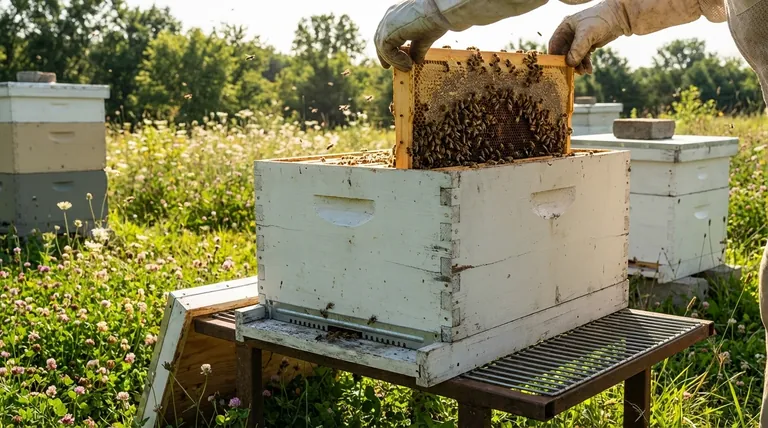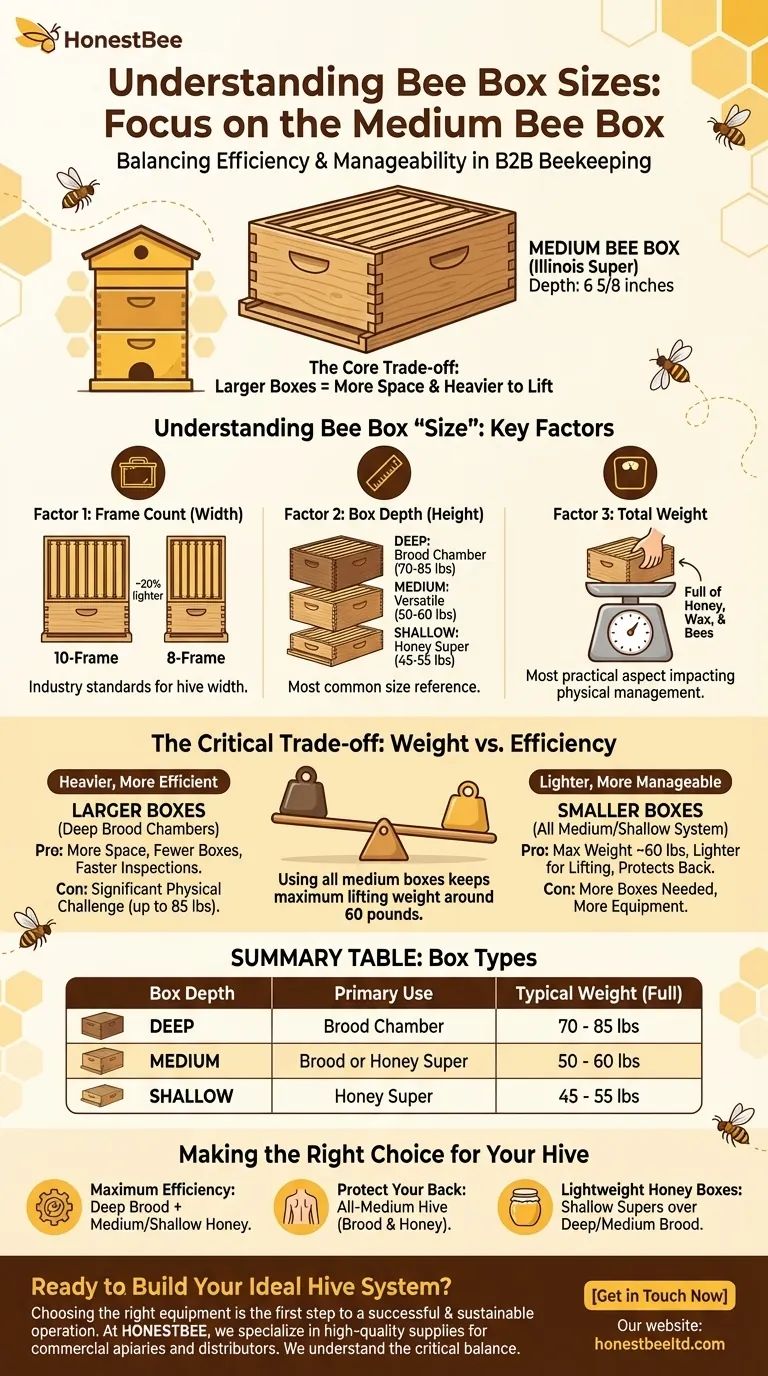A medium bee box, often called an "Illinois Super," is a standard size with a depth of 6 5/8 inches. While its length and width depend on whether it's an 8-frame or 10-frame model, its key characteristic is its manageable weight. A full medium super typically weighs between 50 and 60 pounds, making it a versatile choice for both honey collection and brood rearing.
The core decision in choosing a bee box size is not about exact dimensions, but about managing a fundamental trade-off: The larger the box, the more space for bees and honey, but the heavier it becomes to lift.

Understanding Bee Box "Size": The Three Key Factors
The term "size" in beekeeping refers to a combination of three distinct variables. Understanding each is crucial for building a hive that works for you and your bees.
Factor 1: Frame Count (Width)
The first choice you make is the width of your equipment, determined by the number of frames it holds. The two industry standards are 8-frame and 10-frame.
A 10-frame hive is the traditional standard, offering more space for brood and honey. However, an 8-frame hive is narrower, and every box will be about 20% lighter, a significant difference for the beekeeper.
Factor 2: Box Depth (Height)
The height of the box is what most beekeepers are referring to when they talk about size. There are three standard depths.
- Deep: These are the largest boxes, primarily used as brood chambers where the queen lays her eggs. A full deep box can weigh 70 to 85 pounds.
- Medium: This is the versatile middle ground. It can be used as a honey super (a box for storing honey) or even as a lighter brood chamber. A full medium box weighs 50 to 60 pounds.
- Shallow: These are the lightest boxes, used almost exclusively as honey supers. Their lower weight, around 45 to 55 pounds, makes them easier to handle.
Factor 3: Total Weight
The resulting weight of a box full of honey, wax, and bees is the most practical aspect of its "size." This is the factor that most directly impacts your physical ability to manage the hive throughout the season.
The Critical Trade-off: Weight vs. Efficiency
Choosing your equipment isn't just a matter of preference; it's about balancing the needs of the bees with the physical limitations of the beekeeper.
Why Weight is Often the Deciding Factor
Beekeeping involves repeatedly lifting and moving heavy boxes. An 85-pound deep box can be a significant physical challenge, leading many beekeepers to opt for systems with lighter components.
Using all medium boxes for both brood and honey is a popular strategy to keep the maximum lifting weight around 60 pounds.
The Advantage of a Single Size
Committing to one box depth, such as all mediums, creates a highly efficient and interchangeable system. Any frame can be moved to any box in the hive.
This simplifies management, as you can easily move frames of honey, pollen, or brood between boxes to strengthen or reconfigure the colony as needed.
The Downside of Smaller Boxes
While a system of all medium boxes is lighter, it requires more boxes to equal the volume of a deep box. This means you have more equipment to buy, build, and inspect.
A standard two-box deep brood chamber holds more space than three medium boxes, meaning inspections in a deep hive can sometimes be faster.
Making the Right Choice for Your Hive
Your decision should be based on your physical ability and beekeeping philosophy.
- If your primary focus is maximum efficiency: The traditional setup of deep boxes for brood and medium or shallow boxes for honey is a proven method.
- If your primary focus is protecting your back: An all-medium hive for both brood and honey is the most popular weight-conscious choice.
- If your primary focus is lightweight honey boxes: Using shallow supers over a deep or medium brood chamber makes honey harvesting much easier to manage.
Ultimately, the best hive is one you can manage safely and consistently, so choose the system that best fits your goals and physical comfort.
Summary Table:
| Box Depth | Primary Use | Typical Weight (Full) |
|---|---|---|
| Deep | Brood Chamber | 70 - 85 lbs |
| Medium | Brood or Honey Super | 50 - 60 lbs |
| Shallow | Honey Super | 45 - 55 lbs |
Ready to Build Your Ideal Hive System?
Choosing the right equipment is the first step to a successful and sustainable beekeeping operation. At HONESTBEE, we specialize in supplying durable, high-quality beekeeping supplies and equipment to commercial apiaries and distributors.
We understand the critical balance between hive efficiency and the physical demands of beekeeping. Let us help you build a system that works for you.
Contact our experts today to discuss your specific needs and explore our wholesale-focused product lines. We're here to support your success.
Visual Guide

Related Products
- Portable Bee Mating Hive Boxes Mini Mating Nucs 8 Frames for Queen Rearing
- Professional Insulated Plastic Bee Hives
- Wholesales Dadant Size Wooden Bee Hives for Beekeeping
- Langstroth Honey Bee Box Hive Boxes for Different Depths
- 7 x Auto Bee Flow Hive Frames Plastic Beekeeping Hive Box Supplies
People Also Ask
- What frames should be removed from a queenless, full-size colony when requeening with a nuc? A Strategic Guide for Success
- What is a baby nuc or mating nuc used for? A Guide to Efficient Queen Rearing
- How do you attract bees to a new bee box? Lure Swarms with Proven Scent & Location Strategies
- What is the advantage of using a single deep body for nucs? Achieve 'Grow-in-Place' Hive Success
- Why is it important to monitor bees after relocation? Essential Guide for Apiary Success



















